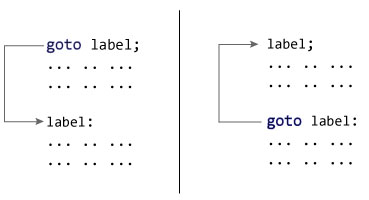In C++ programming, goto statement is used for altering the normal sequence of program execution by transferring control to some other part of the program.
Syntax of goto Statement
goto label;
... .. ...
... .. ...
... .. ...
label:
statement;
... .. ...In syntax above, label is an identifier. When goto label; is encountered, the control of program jumps to label: and executes the code below it.

Example 1: goto Statement
/* C++ program to demonstrate the working of goto statement. */
/* This program calculates the average of numbers entered by user. */
/* If user enters negative number, it ignores that number and
calculates the average of number entered before it.*/
# include <iostream>
using namespace std;
int main() {
float num, average, sum = 0.0;
int i, n;
cout<<"Maximum number of inputs: ";
cin>>n;
for(i=1; i <= n; ++i) {
cout<<"Enter n"<<i<<": ";
cin>>num;
if(num < 0.0) {
goto jump; /* Control of the program moves to jump; */
}
sum += num;
}
jump:
average=sum/(i-1);
cout<<"\nAverage = "<<average;
return 0;
}Output
Maximum number of inputs: 10
Enter n1: 2.3
Enter n2: 5.6
Enter n3: -5.6
Average = 3.95You can write any C++ program with use of goto statement and it is generally considered good idea not to use goto statement.
Reason to Avoid goto Statement
The goto statement gives power to jump to any part of program but, makes the logic of the program complex and tangled. In modern programming, goto statement is considered a harmful construct and a bad programming practice.
The goto statement can be replaced in most of C++ program with the use of break and continue statements.
